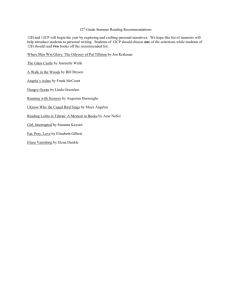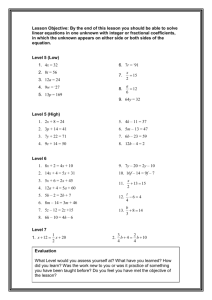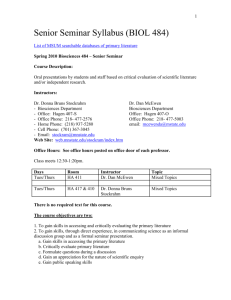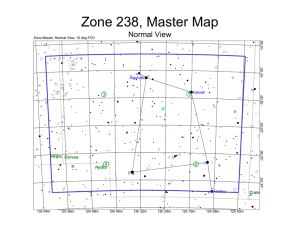18.085 PROBLEM SET 1 SOLUTIONS Problem (1.1.9). Solution. Let c
advertisement
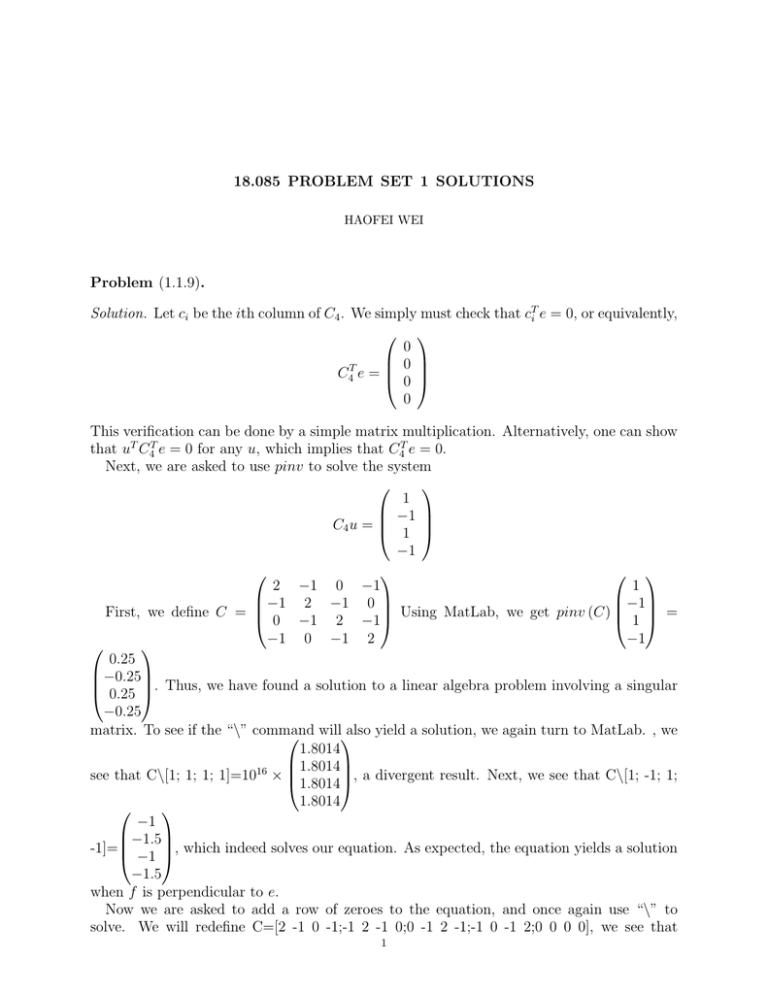
18.085 PROBLEM SET 1 SOLUTIONS HAOFEI WEI Problem (1.1.9). Solution. Let ci be the ith column of C4 . We simply must check that cTi e = 0, or equivalently, 0 0 C4T e = 0 0 This verification can be done by a simple matrix multiplication. Alternatively, one can show that uT C4T e = 0 for any u, which implies that C4T e = 0. Next, we are asked to use pinv to solve the system 1 −1 C4 u = 1 −1 1 2 −1 0 −1 −1 −1 2 −1 0 First, we define C = 0 −1 2 −1 Using MatLab, we get pinv (C) 1 = −1 −1 0 −1 2 0.25 −0.25 0.25 . Thus, we have found a solution to a linear algebra problem involving a singular −0.25 matrix. To see if the “\” command willalso yield a solution, we again turn to MatLab. , we 1.8014 1.8014 see that C\[1; 1; 1; 1]=1016 × 1.8014, a divergent result. Next, we see that C\[1; -1; 1; 1.8014 −1 −1.5 -1]= −1 , which indeed solves our equation. As expected, the equation yields a solution −1.5 when f is perpendicular to e. Now we are asked to add a row of zeroes to the equation, and once again use “\” to solve. We will redefine C=[2 -1 0 -1;-1 2 -1 0;0 -1 2 -1;-1 0 -1 2;0 0 0 0], we see that 1 HAOFEI WEI 18.085 PROBLEM SET 1 SOLUTIONS −0.0802 −0.2355 C\[1;1;1;1;0]=10− 15 × −0.5023 ≈ 0, which also fails as a solution. However, C\[1;-1;1;0 0.5 0 1;0]= 0.5, which is also a possible solution. 0 Problem (1.1.16). Solution. The first method of multiplication is by rows, which gives 2 3 4 5 1 1×2+2×3 8 = = 2 1×4+2×5 14 The second method uses multiplication by columns, which gives 2 3 1 2 3 8 =1× +2× = 4 5 2 4 5 14 Problem (1.1.27). Note: this problem can be found in the online version of chapter 1 of the book −1 1 0 0 2 −1 0 Solution. Given A0 = 0 −1 1 0, we are asked to show A0 AT0 = K3 = −1 2 −1. 0 0 −1 1 0 −1 2 It is an elementary multiplication which may be done in MatLab, and from that multiplication we see that A0 AT0 = K3 . 1 0 0 In order to get T3 , we would delete the first column of A0 to get A1 = −1 1 0. 0 −1 1 1 −1 0 Using MatLab again, we can see that A1 AT1 = T3 = −1 2 −1. 0 −1 2 1 0 Finally, we can delete the last column of A1 to get A2 = −1 1 . Finally, using 0 −1 1 −1 0 MatLab, we will get A2 AT2 = B3 = −1 2 −1. 0 −1 1 Problem (1.2.4). 2 HAOFEI WEI 18.085 PROBLEM SET 1 SOLUTIONS 1 0 −1 1 Solution. We have two matrices, ∆− = .. . 1 1 = . . . 1 0 and M . sum .. 1 1 . 0 . .. 1 1 −1 1 1 To check that the two matrices are inverses, we must verify that ∆− Msum = Msum ∆− = I. The first order of multiplication gives i−1,j i,j Let A = ∆− Msum . We see element aij,i>1 of A can be given by −Msum + Msum . For i > j, both summands are 0, whereas for i < j, both summands are equal to 1, resulting in a sum of 0 in both cases. For i = j, the first summand is 0 and the second summand is 1, resulting in a sum of 1. Finally, for i = 1, we see with simple multiplication that a11 = 1 and ai,j>1 = 0. Thus, A = I. nj Now let B = Msum ∆− . Element bij of B can be given by Σn=i n=1 ∆− . For i < j, the total sum comes out to be −1 + 1 = 0, whereas for i > j, all the summands are 0. For i = j, the only nonzero summand will be 1, giving us B = I. From these two multiplications, we see that ∆− and Msum are inverses. Next, we are asked to find ∆0 = 12 (∆+ + ∆− ). Through simple matrix addition, we find that −1 1 0 1 1 −1 0 0 −1 1 1 0 = + .. .. .. . 2 . 1 . . 0 −1 . . 1 0 −1 −1 1 −1 0 u1 0 1 0 For n = 3, we have ∆0 u = 12 −1 0 1 u2 = 0. By inspection, we can see that u3 0 −1 0 1 u1 = u3 and u2 = 0. Thus, any solution of the form a × 0, where a is any number, will 1 solve the system. 0 1 0 0 0 u1 −1 0 u 2 1 0 0 u3 = 0. Again by inspection, 0 −1 0 1 0 For n = 5, we have ∆0 u = 21 0 0 −1 0 1 u4 0 0 0 −1 0 u5 1 0 we can see that u2 = u4 = 0 and u1 = u3 = u5 . Thus, any solution of the form a × 1, a 0 1 any number, will solve the system. 1 0 −1 1 .. . Problem (1.2.7). 3 HAOFEI WEI 18.085 PROBLEM SET 1 SOLUTIONS Solution. First, we will consider the u = 1 case. In this case, u0 = 0, and the approximation gives −1 + 8 − 8 + 1 =0 12h Next, we will consider the u = x2 case. In this case, u0 = 2x, and the approximation gives −(x + 2h)2 + 8(x + h)2 − 8(x − h)2 + (x − 2h)2 12h 1 = × −x2 − 4xh − 4h2 + 8x2 + 16h + 8h2 − 8x2 + 16xh − 8h2 + x2 − 4h + 4h2 12h (32 − 8)xh = 2x = 12h which matches our exact solution. Finally, we will consider the u = x4 case. In this case, u0 = 4x3 , and the approximation gives = = = = −(x + 2h)4 + 8(x + h)4 − 8(x − h)4 + (x − 2h)4 12h 1 [(x − 2h)2 + (x + 2h)2 ][(x − 2h)2 − (x + 2h)2 ] + 8[(x + h)2 + (x − h)2 ][(x + h)2 − (x − h)2 12h 1 2 (2x + 8h2 )(−8xh) + 8(2x2 + 2h2 )(4xh) 12h (−16 − 64 + 64 + 64)xh2 12h 4x3 which again matches our exact solution. Note that in the above cases, the error is 0 because the 5th derivative of all these functions are 0. We must also find the coefficient b of the 5th order error. To do this, we must use Taylor series expansions of u. To that end, we only need to consider the 5th order terms in 5 d5 u the Taylor expansions of u(x + 2h), u(x + h), u(x − h), and u(x − 2h), which are 32h , 120 x5 h5 d5 u h5 d5 u 32h5 d5 u , − 120 x5 , and − 120 x5 respectively for the 4 functions. Plugging these into our 120 x5 4 h5 −48h5 approximation equation, we get bh4 = 12h×120 (−32 + 8 + 8 − 32) = 12h×120 = − h30 . Thus, b = −1 . 30 Problem (1.2.18). Solution. For a second order finite difference approximation with boundary conditions u(0) = u(1) = 0, K is the proper matrix to use to approximate the second derivative. Since we have n = 4, we must have 4 points between 0 and 1, meaning we will have a stepsize of 1 2 h = 1/5. Thus, the equation we must solve is − h12 Ku = h 3. Note here −K is used as 4 d2 u K is actually the matrix for − dx2 . Since K is not a singular matrix, we can use MatLab’s 4 HAOFEI WEI 18.085 PROBLEM SET 1 SOLUTIONS “\” to easily solve this matrix equation. Using MatLab, we will find that 2 −1 0 0 1 −1 2 −1 0 \ 2 u = −h3 0 −1 2 −1 3 0 0 −1 2 4 4 1 7 = − 125 8 6 To find the exact solution, we will simply integrate the differential. After integrating, we have u = − 16 x3 + Cx + D. To fit the initial condition u(0) = 0, we see D = 0. To fit the initial condition u(1) = 0, we see that C = − 16 . Thus, the exact solution of this equation 1 4 2 , we get u = − 1 7, exactly is u(x) = − 61 x3 − 16 x. Plugging in values of x = 15 125 8 3 4 6 matching our finite difference method. The reason that we have an exact match between the two solutions is because the finite difference method, as we saw in an earlier problem, has an error proportional to the 5th derivative of the function. For our function, the 5th derivative is 0, so there is no error between the exact and finite difference methods. 5
